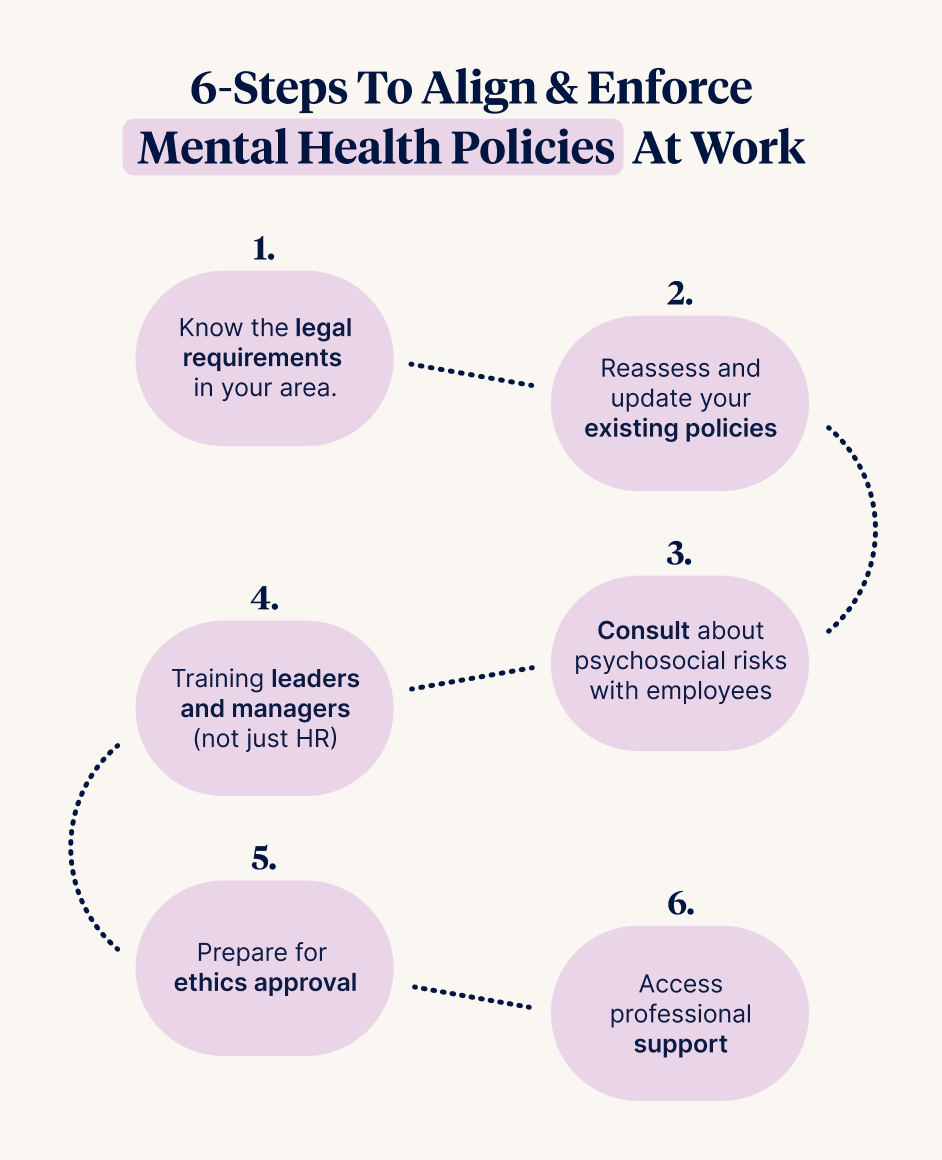Many workplaces include references to mental health in their employee handbook or code of conduct. But is this enough?
Mental health has become a hot topic in workplace regulations (and a mainstream topic in everyday conversations), and businesses are now realising that their policies and management training haven’t kept pace with the law or employee expectations.
Through Talked’s EAP, I’ve spoken with many business leaders from SME’s to large enterprises who are unsure about what’s expected of them;
- Are their managers trained to spot and respond to mental health risks?
- Do their existing policies meet legal standards?
- What proactive steps are they and their organisations taking to reduce psychological hazards and promote employees’ wellbeing?
These are important questions. Getting them right affects not just a company’s legal exposure but also the team’s culture, happiness, and attractiveness to potential hires.
Legal Context of Workplace Mental Health
Australia’s legal framework around workplace mental health is built on several key pieces of legislation, including Work Health and Safety (WHS) laws, the Fair Work Act, Privacy Act, and anti-discrimination laws at the Federal and State levels.
In November 2024, Safe Work Australia released an updated code of practice on psychosocial hazards. This offered clearer guidance on an employers’ duties to identify, reduce, and manage psychosocial risks in the workplace.
The revised code addresses hazards that had previously received limited attention, including fatigue, intrusive surveillance, and job insecurity. These additions acknowledge the shifting nature of workplace risks, particularly as flexible work arrangements, widespread use of technologies such as AI tools, and organisational restructuring.
How to Align and Enforce Mental Health Policies at Work
A workplace mental health policy is only valuable if it complies with both the relevant State and Federal legislation and is consistently applied in day-to-day operations.
It’s not enough to simply have policies on paper; these policies need to be clear, compliant, and backed by meaningful action.
Below are some tips to create and implement mental health policies that actually support your employees’ wellbeing.

1. Get to know the legal requirements in your area
Each State and Territory in Australia applies its own workplace health and safety legislation. The specific legal duties around mental health can vary slightly depending on your location, so it’s essential to familiarise yourself with the laws applicable to you.
Here are some key resources for state- and territory-specific guidance:
| State / Territory | Guidance |
| New South Wales | View SafeWork NSW: Legal obligations |
| Victoria | View WorkSafe Victoria: Psychological health regulations |
| Queensland | View WorkSafe QLD: Mental health resources |
| Western Australia | View Worksafe WA: Psychosocial hazard resources |
| South Australia | View WorkSafe SA: Psychosocial hazard resources |
| Tasmania | View WorkSafe Tasmania: Psychosocial hazard resources |
| Australian Capital Territory | View WorkSafe ACT: Psychosocial hazard resources |
| Northern Territory | View WorkSafe NT: Workplace mental health resources |
It’s important to review these resources regularly, as guidance can change over time. If you're unsure about how to interpret specific legal requirements, you should seek advice either from your legal team, a workplace health and safety consultant, or your local WHS regulator.
2. Reassess and update your existing policies
Workplace policies should keep pace with both legal changes and shifting employee expectations. As you review your area’s workplace mental health legislation, you should also thoroughly review your current policies to ensure they explicitly address psychological safety and clearly define responsibilities at every level.
A strong mental health policy should also spell out what’s expected of both leaders, managers and staff, provide clear and confidential reporting pathways, and establish a regular review schedule to keep the policy relevant.
I personally recommend that, in addition to this information being provided during orientation, it be regularly discussed during team meetings. Whether it’s sharing links to internal resources or direction on how to access external support (such as an EAP).
3. Consult employees about psychosocial risks
Employee consultation is a legal requirement under WHS laws. Meaningful consultation is the most direct way to identify and understand psychosocial risks present within your organisation. Psychosocial risks can differ between organisations, so taking the time to consult with your team can help uncover stressors that may not be immediately obvious to your leadership team.
I recommend that you create regular, structured opportunities for employees to share feedback on their workload, work environment, team dynamics, and other factors that affect their mental health.
This could be done through anonymous surveys (like the People at Work risk assessment), focus groups, and individual check-ins. My personal favourite is quarterly skip-level meetings, which provide opportunities for junior staff to interact with more senior levels of leadership.
For high-risk sectors and companies with known mental health hazards, it’s best practice to enable employees to elect Health and Safety Representatives (HSRs) who can represent the workers in all crucial, health-related assessments and discussions.
Employees should also be informed of actions taken post-consultations to let them know their inputs were taken seriously and acted upon. Actions speak louder than words. Sharing these outcomes not only demonstrates accountability but also reinforces a culture of trust and continuous improvement.
4. Train your leaders and managers (not just your HR team)
While HR usually takes the lead on mental health compliance, managers and team leaders have the most direct, day-to-day impact on employee wellbeing. That’s why it’s essential to provide all leaders with practical training on workplace mental health, covering key topics like WHS obligations, anti-discrimination laws, and how to recognise and respond to signs of psychological distress.
Enabling trauma-informed leadership is another best practice. Trauma-informed leadership helps managers understand how past trauma can affect an employee’s behaviour and mental health. It equips them with strategies to handle difficult situations with care, while avoiding actions that could unintentionally cause further stress or harm.
While particularly important in high-pressure industries, this type of leadership can benefit any workplace by creating a culture of empathy, trust, and resilience.
5. Embed mental health into your workplace culture
A mentally healthy culture goes beyond compliance checklists. It’s about creating an environment where people know and feel they can safely speak up, set boundaries, and give and receive support. Organisations that prioritise this type of culture often benefit from higher engagement, better retention, and improved overall performance.
Policies should be treated as active tools, not static documents. Make them part of daily operations. Reinforce key principles during onboarding, team training, leadership meetings, one-on-one check-ins, town halls, and even in the way workloads are delegated and managed. Other best practices to consider are:
- Encouraging regular breaks and time off
- Modelling healthy work-life balance
- Avoiding praise for overwork or long hours
- Checking in regularly with team members
- Offering flexibility where possible
- Responding promptly and sensitively to mental health concerns
These practices send a strong message that mental health is genuinely valued, not stigmatised or simply discussed for the sake of compliance.
6. Regularly review and adapt your approach
Psychosocial risks evolve as your organisation grows, changes, or faces new challenges.
Set up a formal review cycle to revisit your risk assessments, policy documents, training programs, and team rituals, ideally at least once a year or during critical events like company restructures and remote or hybrid work transitions.
I recommend involving employees in these reviews to ensure your approach is grounded in real experience, not just theory or assumptions.
Final Thoughts
Aligning your mental health policies with current legislation and best practices allows you to create a workplace where employees feel genuinely supported, safe, and able to thrive.
Well-designed and properly enforced policies not only protect mental health but also build trust, boost morale, and promote a culture where people are more engaged and committed.
The benefits for businesses are just as clear. Investing in mental health strategies leads to stronger retention, lower absenteeism, higher productivity, and a more resilient workforce overall. It also reduces legal risks and enhances your reputation as an employer of choice.
If you’re ready to review your company’s mental health strategies, I encourage you to consider where policies and culture intersect. That’s where meaningful change happens, and where businesses can thrive.



